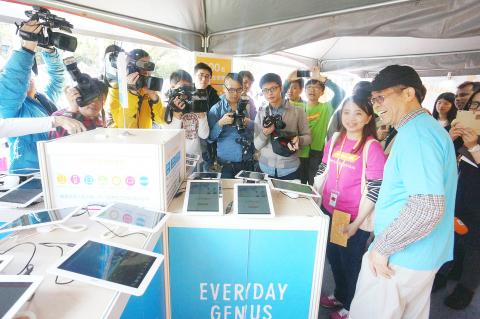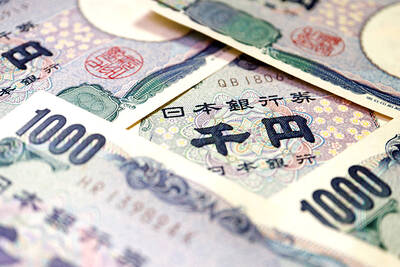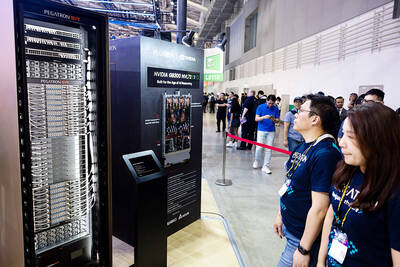MediaTek Inc (聯發科), which designs chips used in smartphones from major Chinese brands including Xiaomi Corp (小米) and Lenovo Group (聯想), yesterday launched a global recruitment program to hire 2,000 new employees to cope with the company’s rapidly growing businesses.
MediaTek launched the program at a jobs fair held by National Taiwan University in Taipei yesterday. The program is part of the company’s broader efforts to boost its research and development capabilities to prepare for intensifying competition.
“MediaTek has 10,000 employees working in 27 locations in 12 countries. They work in different divisions, including marketing, research and development and customer services,” MediaTek chairman Tsai Ming-Kai (蔡明介) said during a speech at the jobs fair.

Photo: CNA
“MediaTek offers an environment for employees to learn and grow with world-class talents,” Tsai said.
To support the company’s strong growth this year and in the longer term, MediaTek plans to boost research and development spending by 20 percent annually this year, as it foresees a need to develop advanced patents for 4G long-term evolution (LTE) technology, the firm said.
MediaTek allocated 20.3 percent of its total revenue for research and development last year, according to statistics released two weeks ago by IC Insights Inc.
Meanwhile, MediaTek aims to double its LTE market share in China to 40 percent this year, taking on larger rival Qualcomm Inc.
“This year will be another year of investment for MediaTek. We will significantly expand research and development resources to accelerate development of new products and new technologies,” company president Hsieh Ching-jiang (謝清江) told investors last month.
“We hope to recruit top talent from around the world to broaden our product lines. We also plan to invest on advanced processor manufacturing and cutting-edge technologies,” Hsieh said.
MediaTek is broadening its smartphone chip lineup and expanding into new areas, including chips for wearable devices.
With new products in the pipeline and fast-growing LTE chip demand from China, the company aims to grow its revenue by 10 to 20 percent this year from a record-high of NT$213.06 billion (US$6.74 billion) last year.
To entice high-quality potential candidates, MediaTek is offering salaries starting at NT$1 million per year for new employees with a master’s degree, and those who have earned their doctorate would receive at least NT$1.5 million per year, the company said. The offerings do not include annual employee bonuses or any other compensation.
The Hsinchu-based company yesterday also launched an internship program for 200 college students from Taiwan and overseas to work as apprentices at MediaTek during the summer vacation.

AI TALENT: No financial details were released about the deal, in which top Groq executives, including its CEO, would join Nvidia to help advance the technology Nvidia Corp has agreed to a licensing deal with artificial intelligence (AI) start-up Groq, furthering its investments in companies connected to the AI boom and gaining the right to add a new type of technology to its products. The world’s largest publicly traded company has paid for the right to use Groq’s technology and is to integrate its chip design into future products. Some of the start-up’s executives are leaving to join Nvidia to help with that effort, the companies said. Groq would continue as an independent company with a new chief executive, it said on Wednesday in a post on its Web

RESPONSE: The Japanese Ministry of Finance might have to intervene in the currency markets should the yen keep weakening toward the 160 level against the US dollar Japan’s chief currency official yesterday sent a warning on recent foreign exchange moves, after the yen weakened against the US dollar following Friday last week’s Bank of Japan (BOJ) decision. “We’re seeing one-directional, sudden moves especially after last week’s monetary policy meeting, so I’m deeply concerned,” Japanese Vice Finance Minister for International Affairs Atsushi Mimura told reporters. “We’d like to take appropriate responses against excessive moves.” The central bank on Friday raised its benchmark interest rate to the highest in 30 years, but Bank of Japan Governor Kazuo Ueda chose to keep his options open rather than bolster the yen,

Even as the US is embarked on a bitter rivalry with China over the deployment of artificial intelligence (AI), Chinese technology is quietly making inroads into the US market. Despite considerable geopolitical tensions, Chinese open-source AI models are winning over a growing number of programmers and companies in the US. These are different from the closed generative AI models that have become household names — ChatGPT-maker OpenAI or Google’s Gemini — whose inner workings are fiercely protected. In contrast, “open” models offered by many Chinese rivals, from Alibaba (阿里巴巴) to DeepSeek (深度求索), allow programmers to customize parts of the software to suit their

Global server shipments are expected to surge to 15 million units next year, from 4 million units this year, with artificial intelligence (AI) servers accounting for about 30 percent, driven by massive capital spending by major cloud service providers, the Market Intelligence and Consulting Institute (MIC) said on Thursday last week. Major cloud service providers — including Google’s parent company Alphabet Inc, Microsoft Corp, Amazon.com Inc and Meta Platforms Inc — are projected to budget US$450 million for capital expenditure next year, up from US$400 million this year, MIC ICT [information and communications technology] Industry Research Center director Edward Lin